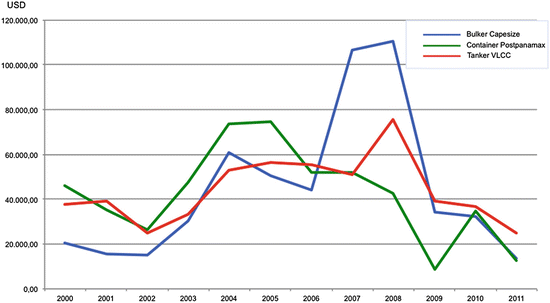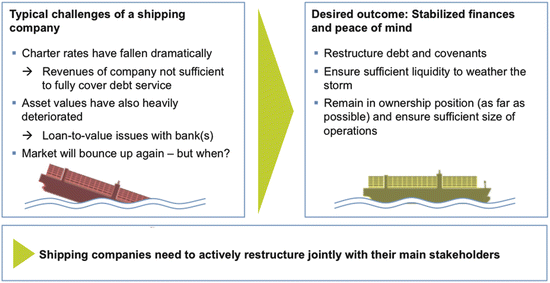Restructurings in Shipping

Fig. 16.1
Development of second-hand vessel prices

Fig. 16.2
Development of charter rates
In this distressed environment, many companies in the shipping sector do not generate enough revenues to fully cover the debt service. This problem is especially observable for vessels, which were ordered at peak prices, and had a high leverage of bank debt. In many cases the operative result of vessels barely covers their operating expenses and perhaps the interest costs to be paid to the banks, but not the repayment of the loan principal.
At the same time, the reduced asset values have led to many loan-to-value problems with the banks. With asset prices falling in some cases more than 50 %, the value of the assets dropped many times below the outstanding loan amount. This is a problem for banks, especially if the loans are only secured by the assets themselves (which is typical in the shipping sector, with the vessels being owned by single-purpose companies, with a nonrecourse status to the parent company). Figure 16.3 gives an overview of the effect on loan-to-value caused by a given decrease in asset value.

Fig. 16.3
Effect of falling asset prices on loan-to-value
As can be imagined, the combination of these effects have caused all sectors of the shipping industry to suffer: The yards, the non-operating owners, the ship management companies, the chartering and broker companies, the liner companies, and the ship financing banks. In addition, while the shipping industry was always of a cyclical nature, the magnitude and the length of this last downturn is especially severe. The first signs of a crisis appeared in the second half of 2008, and in 2012 there was still no sign of a real recovery, with some experts still expecting further trouble to come before an eventual recovery.
In such an environment, it is essential for all stakeholders to find solutions in case of financial distress. Thus, many companies of the shipping sector needed a restructuring. Some of these restructurings could be observed in the open, the company involved being a public company. One example of this is CSAV, the largest South-American liner operator, listed at the Santiago stock exchange, which restructured in the beginning of 2009 (see also the case study at the end of this chapter). Other companies that had to restructure encompass Danaos, Torm, General Maritime, or CMA CGM, to give some examples. However, with many shipping companies being privately held, many restructurings were done in the background, with the involvement of only a small number of stakeholders.
The chart (Fig. 16.4) summarizes why the challenging environment of the shipping sector calls for restructurings of many involved companies.

Fig. 16.4
Shipping companies face a very challenging environment
16.2 Potential Contributions of the Key Stakeholders
It is important in a restructuring process to identify the main stakeholders. Always involved are the shareholders and the banks. However, it is important to also analyze whether further stakeholders can also contribute to a restructuring.
16.2.1 Shareholders
The shareholders of a company play the most important role in a restructuring. Not only can they supply liquidity in the form of a shareholder loan or a capital increase, or give guarantees backed by their personal wealth to the banks in exchange for new loans. They can also agree to sell certain assets of a company to raise cash. In addition, if they cannot contribute with their own cash injections, they can pave the way for a third-party investor to enter the company, which would mean that existing shareholders must accept a dilution.
Moreover, the attitude of shareholders is crucial to a restructuring. Are they flexible and trying to seek solutions jointly with the other stakeholders to save the company? Can they accept with humbleness that their company is in trouble and unable to comply with its obligations? Alternatively, are they playing hardball, trying to block all solutions claiming that the problem lies with the other stakeholders? Depending on the attitude of the shareholders, restructurings with similar starting points can take on very different routes.
It is also very important that shareholders paint a true picture of the state of the company, and lay out all the facts. Transparency about the expected cash inflows and outflows is crucial. Negative surprises of matters that should have been foreseen or which were intentionally not disclosed could severely endanger a restructuring and certainly lead to the other stakeholders to revise what contributions they will carry.
16.2.2 Banks
Banks naturally play a crucial part in all restructurings. This is especially true in shipping, which is a very capital-intensive industry with high leverage, i.e. high amount of debt. Banks have various means for assisting in a restructuring. First of all, they can ease the cash-outflow of a company by accepting a full or partial moratorium on the principle payments. Interest payments can be converted into so-called “payments in kind,” meaning that part of the interest payment is only due at a later stage. Loans can also be restructured to temporarily allow for a “pay-as-you-can” period in which case the company only pays to the banks if its cash flow allows for it.
Furthermore, if the banks believe in the future prospects of a company, it is also not uncommon to supply a bridge facility, i.e. a short-term cash injection to help a company through the crisis. This facility is usually highly priced (high interest, often with a payment-in-kind element), and often combined with a share pledge. This means that if the bridge facility is not repaid, then the bank shall receive (parts of) the shareholdings in the company. Thus, while such a bridge facility is in place, the banks need to give their consent if a sale of the company is intended.
Banks also can pave the way for external capital to enter a company by allowing a tranching of the loans. This usually happens if the LTV of a company is significantly above 100 %. An outside investor in this case would not enter with fresh money if their cash injection were to be fully behind the banks. Thus banks divide their loans into various tranches such as a fully senior tranche and a junior tranche. Usually, the fresh money then enters between the senior and the junior tranche. As the junior tranche has lower possibility to be repaid, it is often also referred to as a “first loss piece.” As can be imagined, banks do not like this approach much, as their internal systems require the junior piece to be rated badly, with subsequent high requirements to allocate equity to this junior loan. Another way to facilitate the entry of an external investor is to take a so-called “haircut” on the loan, meaning to write-off a certain part of the loan. Naturally, this is a last resort for the banks.
Lastly, banks can also convert some of their debt into equity, thus easing the cash outflow of a company significantly. However, banks usually do not like to be in an equity position, so they seek clear exit rules for their shareholdings or already define a way to dispose of the shareholdings at a later point in time.
16.2.3 Other Stakeholders
Other stakeholders that can contribute to a restructuring are usually suppliers and customers. However, it needs to be evaluated carefully whether creating transparency to these groups is beneficial or should be avoided. Customers often have a chance to switch their suppliers on a short notice, which would lead to a reduced cash-inflow for the restructuring company. Here the relative importance of the restructuring company to the stakeholders needs to be evaluated. If the survival of the company is crucial for the suppliers or customers, then they can be asked to contribute to a restructuring. However, if suppliers or customers can switch easily or only little business is done with the restructuring company, then it might be better not to inform these stakeholders about the financial trouble the company is in, if a quick restructuring solution can be found in another way.